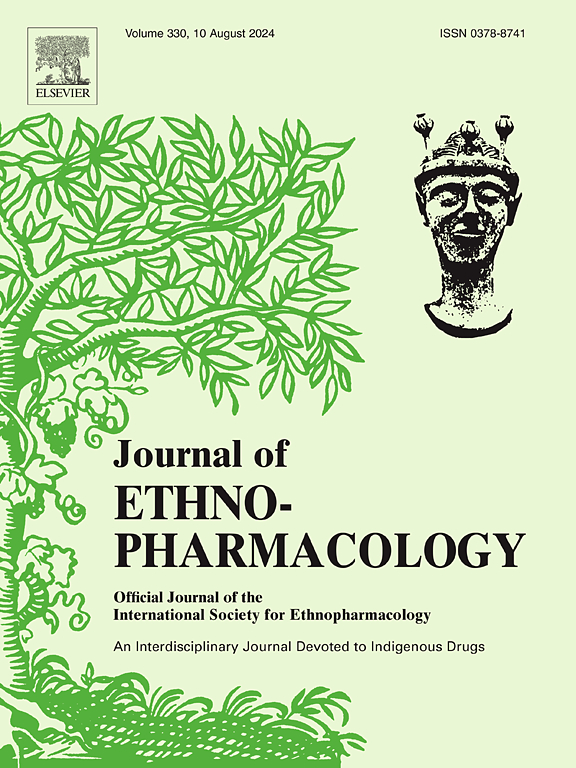Multi-tissue metabolomics and network pharmacology study on the intervention of Danggui Buxue Decoction in mice with gemcitabine induced myelosuppression
IF 5.4
2区 医学
Q1 CHEMISTRY, MEDICINAL
引用次数: 0
Abstract
Ethnopharmacological relevance
The traditional Chinese medicine (TCM) Danggui Buxue Decoction (DBD) was initially recorded in Nei Wai Shang Bian Huo Lun. Known for its immune regulatory and hematopoietic effects, DBD improved the quality of life in non-small-cell lung cancer (NSCLC) patients. Previous research confirmed that DBD can alleviate gemcitabine (GEM) induced myelosuppression. However, the specific metabolic mechanisms underlying this action remain unclear.
Aim of the study
The aim of our study was to explore the metabolic mechanism of DBD against GEM-induced myelosuppression using non-targeted metabolomics and network pharmacology. Additionally, we aimed to validate our findings through enzyme linked immunosorbent assays (ELISA) and Western blot (WB).
Materials and methods
Initially, a GEM-induced myelosuppression model in mice was established by administering GEM (100 mg/kg) twice. Serum, bone marrow nucleated cells (BMNCs) and thymus samples were collected at different time points. Ultra-high-performance liquid chromatography coupled with Q Exactive Orbitrap mass spectrometry (UHPLC-QE-MS/MS) was employed based on non-targeted metabolomics and network pharmacology was conducted to identify the key compounds, core targets and pathways that mediate the effects of DBD. Furthermore, the targets identified through metabolic and network pharmacology were jointly analyzed to select crucial metabolism pathways. Finally, our findings were experimentally validated using ELISA and WB.
Results
The results revealed 116 differential metabolites as metabolic biomarkers of DBD in the treatment of GEM-induced myelosuppression. Among these, pathway analysis was conducted on 32 distinct metabolites with KEGG ID, which were subsequently linked to a joint pathway involving 115 targets of DBD-related disease in the PPI network. Pyrimidine synthesis and histidine (HIS) metabolism were identified as the most critical metabolic pathways for DBD in treating GEM-induced myelosuppression. DBD was found to enhance adenosine production through CD73 and additionally regulate TNF-α IL-8 and IL-10.
Conclusion
In summary, pyrimidine synthesis, HIS metabolism, CD73 and inflammatory factors play significant roles in DBD's alleviation of GEM-induced myelosuppression. In this study, a comprehensive strategy of multi-tissues and multi-time point metabolomics, network pharmacology and pharmacological experiments was used to further illuminate the complex mechanisms of DBD against GEM-induced myelosuppression.

当归补血汤干预吉西他滨致小鼠骨髓抑制的多组织代谢组学及网络药理学研究
中药当归补血汤(DBD)最早见于《内外商边活论》。DBD以其免疫调节和造血作用而闻名,改善了非小细胞肺癌(NSCLC)患者的生活质量。既往研究证实,DBD可减轻吉西他滨(GEM)诱导的骨髓抑制。然而,这种作用背后的具体代谢机制尚不清楚。本研究的目的是利用非靶向代谢组学和网络药理学方法,探讨DBD抗gem诱导的骨髓抑制的代谢机制。此外,我们旨在通过酶联免疫吸附试验(ELISA)和Western blot (WB)验证我们的发现。材料与方法首先用2次GEM (100 mg/kg)诱导小鼠骨髓抑制模型。在不同时间点采集血清、骨髓有核细胞(bmnc)和胸腺标本。采用基于非靶向代谢组学和网络药理学的超高效液相色谱联用Q - qe -MS/MS技术,鉴定了介导DBD作用的关键化合物、核心靶点和通路。此外,通过代谢和网络药理学共同分析确定的靶点,选择关键的代谢途径。最后,我们的研究结果用ELISA和WB进行了实验验证。结果发现116种差异代谢物可作为gem诱导的骨髓抑制治疗DBD的代谢生物标志物。其中,对32种具有KEGG ID的不同代谢物进行了通路分析,随后将其与PPI网络中涉及115个dbd相关疾病靶点的联合通路联系起来。在治疗gem诱导的骨髓抑制中,嘧啶合成和组氨酸(HIS)代谢被认为是DBD最关键的代谢途径。发现DBD通过CD73增加腺苷的产生,并调节TNF-α IL-8和IL-10。综上所述,嘧啶合成、HIS代谢、CD73和炎症因子在DBD减轻gem诱导的骨髓抑制中发挥重要作用。本研究采用多组织、多时间点代谢组学、网络药理学、药理实验等综合策略,进一步阐明DBD抗gem诱导的骨髓抑制的复杂机制。
本文章由计算机程序翻译,如有差异,请以英文原文为准。
求助全文
约1分钟内获得全文
求助全文
来源期刊

Journal of ethnopharmacology
医学-全科医学与补充医学
CiteScore
10.30
自引率
5.60%
发文量
967
审稿时长
77 days
期刊介绍:
The Journal of Ethnopharmacology is dedicated to the exchange of information and understandings about people''s use of plants, fungi, animals, microorganisms and minerals and their biological and pharmacological effects based on the principles established through international conventions. Early people confronted with illness and disease, discovered a wealth of useful therapeutic agents in the plant and animal kingdoms. The empirical knowledge of these medicinal substances and their toxic potential was passed on by oral tradition and sometimes recorded in herbals and other texts on materia medica. Many valuable drugs of today (e.g., atropine, ephedrine, tubocurarine, digoxin, reserpine) came into use through the study of indigenous remedies. Chemists continue to use plant-derived drugs (e.g., morphine, taxol, physostigmine, quinidine, emetine) as prototypes in their attempts to develop more effective and less toxic medicinals.
 求助内容:
求助内容: 应助结果提醒方式:
应助结果提醒方式:


